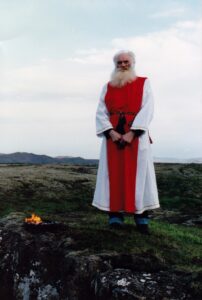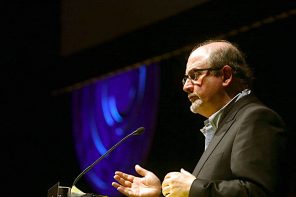This month an Icelandic Pagan organization called the Ásatrúarfélag (roughly translated,* “the fellowship of those who trust in the ancient gods”) will begin construction of a temple in Öskjuhlíð hill, Reykjavík. It will be the first heathen temple to be built in Northern Europe since the construction of the Temple at Uppsala in Sweden in 1070. More importantly, the temple symbolizes the arrival of the Ásatrúarfélag, founded in 1972, into

Image of Beinteinsson in 1991 by Jónína K. Berg is licensed under CC-BY-SA 3.0.*
Iceland’s religious mainstream. The progress of the Ásatrúarfélag is an index of a move in Western society toward a broader sense of religious pluralism that includes not only Abrahamic religions but also indigenous faiths and new religious movements.
During an “Althing” assembly in 1000 CE, Iceland adopted Christianity as its national religion. But the people were still free to worship the old gods such as Odin, Thor, and Freya. Icelandic scholars such as Snorri Sturluson (1179-1241) preserved many of the stories and sagas of Norse tradition. When Iceland fell under control of Denmark from the thirteenth century until World War II, stories of the old gods became linked to ideas of independence and nationalism.
In 1972 the Ásatrúarfélag was formed by a group of artists and intellectuals led by Sveinbjörn Beinteinsson, a farmer and poet. The early movement drew from many of the same Romantic currents of the 1960s that in the United States led to the cult of Tolkien and the founding of the Society for Creative Anachronism. Beinsteinsson regarded Christianity as an alien religion and wanted Icelanders to have a faith of their own,** more connected to the land.
When the Ásatrúarfélag sought to become a legally recognized religion they were met with resistance from Sigurbjörn Einarsson, Iceland’s Lutheran bishop. Einarsson argued* that while Iceland’s constitution granted everyone the right to “found organizations to serve god,” this meant only monotheistic religions; The faith of Beinsteinsson and his friends was polytheistic and enjoyed no Constitutional protections.
Einarsson also suggested that the worship of Norse gods could not be separated from the racist ideology of the Nazis. Other critics* piled on, claiming that everyone seemed content with Jesus save for Hitler and Stalin. (Michael Strmiska, a leading ethnographer of modern Paganism, did not detect any racist elements while observing the Ásatrúarfélag). Despite these objections, Ásatrúarfélag became a legally recognized religion in 1973 and has gained increasing acceptance ever since. Beinsteinsson’s funeral in 1993 was broadcast on national television.
The debate over whether Iceland’s constitution applies to polytheistic or Pagan religions parallels contemporary debates in the United States, especially in the wake of groups like The Satanic Temple who have demanded the same privileges enjoyed by the Christian establishment. Following the Greece v. Galloway decision, which authorized public prayers before government events, Chaz Stevens of Florida offered to open a town council meeting with a prayer to Satan. In response, conservative pastor Mark D. Boykin asserted that the first amendment applies only to religions “like Christianity” and not “malevolent and evil” religions. Boykin added that Satanism is “the spirit of Charles Manson, Jeffery Dahmer, the Columbine murders.” Much as early opponents of the Ásatrúarfélag alluded to Hitler and Stalin, Boykin conjured a dubious network of threats as an argument for denying legal rights to new religions.
Stevens’ satirical antics cannot be compared to the spirituality of Beinteinsson and the Icelandic constitution is different from that of the United States. But the contours of these controversies are the same. Both involve a minority seeking an alternative to the cultural authority of Christianity and a conservative Christian response seeking to shore up a definition of religious freedom that excludes these alternatives. In the long run, it seems that our legal understanding of religious pluralism is destined to expand rather than contract. Iceland’s new temple to the Norse gods symbolizes the ability of a Western democracy to host a growing array of religious organizations.
Corrections: (*) Link to source material has been added. (**) Quotation marks, inserted by the editor, have been removed from “a faith of their own.” RD regrets the errors.




